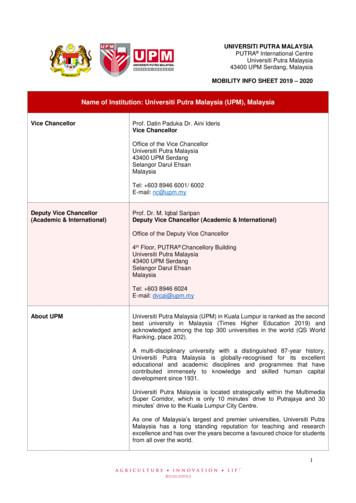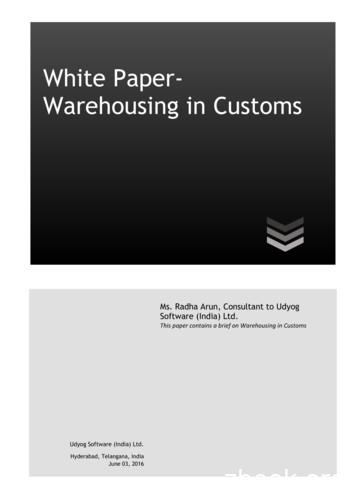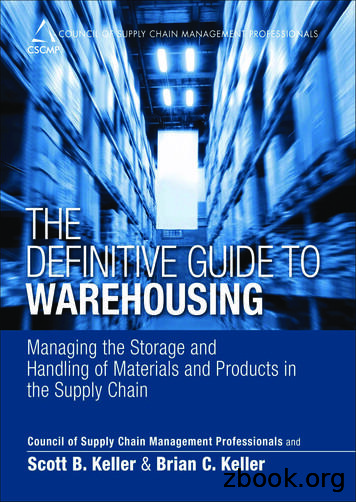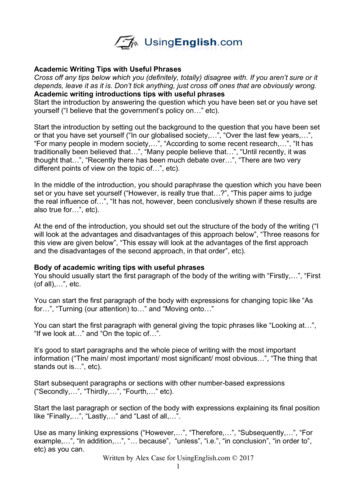Warehousing Services In Malaysia
Chapter7Warehousing Services in MalaysiaMohd Yazid Abdul Majid, Goh Swee Sean and Lok Lee LeeOctober 2018This chapter should be cited asAbdul Majid, M.Y., S.S. Goh and L.L. Lok (2018), ‘WarehousingServices in Malaysia’, in Gross, Jeremy and P.S. Intal, Jr. (eds.),Reducing Unnecessary Regulatory Burdens in ASEAN: Country Studies,Jakarta: ERIA, pp.176-219.
CHAPTER 7Warehousing Services in MalaysiaMohd Yazid Abdul MajidGoh Swee SeangLok Lee LeeMalaysia Productivity Corporation (MPC)[ 1 ] IntroductionRegulatory burdens arise from costs imposed on businesses by regulationsand enforcement. While some burdens are necessary to help businessesachieve their objectives, others are created by poorly designed, implemented,or administered regulations, and by unnecessary regulatory duplication andinconsistency.Priority areas where regulations need to be improved, consolidated, or removedmust be systematically reviewed and identified. Reducing unnecessaryregulatory burdens is part of the reforms to improve Malaysia’s productivityand competitiveness. The Malaysia Productivity Corporation (MPC) isleading a comprehensive review of regulations to remove unnecessary rulesand compliance costs, starting with regulations that impact the national keyeconomic areas.176The Tenth Malaysia Plan, 2011–2015 mandated MPC to carry out regulatoryreviews to ease doing business in Malaysia (EPU, 2010). These reviews drewon the expertise and perspectives of representative stakeholders from thepublic and private sectors. The MPC undertook several initiatives under theModernising Business Licensing programme to simplify procedures and builda business-friendly regulatory environment in support of the nation’s overalldevelopment goals. These initiatives culminated in the introduction of theNational Policy on the Development and Implementation of Regulations,aimed at implementing good regulatory practice across all federal ministries andagencies.
WAREHOUSING SERVICES IN MALAYSIAThe Eleventh Malaysia Plan, 2016–2020 reiterates the government’scommitment to make public services more efficient and productive (EPU,2015b) by eliminating unnecessary bureaucratic processes, including those thatslow down approval of licences and permits as well as those rules and regulationsthat are not in line with current needs.The Services Sector Blueprint (2015–2020) (EPU, 2015a) mandates MPCto reform sectoral governance and remove structural barriers and outdatedregulations by accelerating and increasing the efficiency of sectoral governancereform, and ensuring that the best regulatory development practices expandand accelerate the adoption of the National Policy on the Development andImplementation of Regulations.Amongst the five strategic thrusts of the Malaysia Productivity Blueprint,launched on 8 May 2017 is ‘Forging a Robust Ecosystem’, which aims to addressregulatory constraints and develop a robust accountability system to ensurethat regulatory reviews are effective. The blueprint recommends expanding theglobally used guillotine approach to rapidly streamline regulations: each ministrymust list business regulations within their purview and highlight those no longerrelevant or justified. All cross-agency and cross-ministerial regulations must alsobe reviewed.[ 2 ] Background of the Priority SectorLogistics, trade facilitation, and competitiveness are at the forefront of policydiscussions in Malaysia. According to the World Bank’s Malaysia EconomicMonitor (2016), about 40% of jobs are linked with export activities and theratio of trade to gross domestic product of 148% (2010–2014). Trade hasbeen the engine of Malaysia’s growth in the last 40 years. Indeed, efficient andhigh-performing logistics and trade facilitation are important determinants of acountry’s competitiveness as well as an important source of employment.Amongst the focus areas under the Eleventh Malaysia Plan is ‘unleashinggrowth of logistics and enhancing trade facilitation’, where the country aspiresto become the preferred logistics gateway to Asia, and improve its ranking in177
178REDUCING UNNECESSARY REGULATORY BURDENS IN ASEAN: COUNTRY STUDIESthe World Bank’s Logistics Performance Index (2016) from being amongstthe top 25 in 2014 to amongst the top 10 by 2020. The Logistics and TradeFacilitation Master Plan (2015–2020) provides the strategic framework toresolve bottlenecks in the logistics sector and elevate Malaysia to become aregional player in the medium term. As the backbone of the global supply chain,the logistics industry is vital to competitiveness and connectivity as it stimulatestrade, encourages efficiency, and enhances growth.Warehousing is part of logistics and supply-chain management. Logisticscovers a wide range of areas, including storage, warehousing, trucking services,and equipment maintenance, with transportation as its core component.Institutional and regulatory framework issues are related to lack of coordination,inefficient and insufficient regulations, as well as lack of data management. Thecoordination issues in logistics are attributed to the overlapping functions ofagencies and to institutional gaps. Off-dock depots and ordinary warehouses areinefficient and poorly regulated. The database for land freight is fragmented andthus impedes effective planning and development.Warehousing is, therefore, viewed as a significant cross-cutting component forregulatory review. Regulations that stifle the competitiveness of warehousing willdiminish that of logistics and other related industries.[3] O verview of Warehousin EconomicPerformanceThe Malaysia Standard Industrial Classification 2008 classifies all economicactivities in Malaysia that adopt the International Standard IndustrialClassification Revision. Warehousing business activities are based on Division52 (Warehousing and Support Activities for Transportation) under Section H(Transportation and storage) of the Malaysia Standard Industrial Classification2008 (Table 1).
WAREHOUSING SERVICES IN MALAYSIATable 1: Industries Included in the ReviewClassItemDescriptionDivision 52: Warehousing and Support Activities for TransportationGroup 521: Warehousing and storage5210Warehousing and storageInclude(a) operation of storage and warehouse facilities forall kinds of goods: operation of grain silos, generalmerchandise warehouses, freight, refrigeratedwarehouses, storage tanks, etc.;(b) storage of goods in foreign trade zones;(c) blast freezing52100Exclude(a) parking facilities for motor vehicles (see 52213);(b) operation of self-storage facilities (see 68102);(c) rental of vacant space (see 6810)Warehousing and storage servicesGroup 522: Support activities for transportation5224(1)Cargo handling52249Other cargo handling activities n.e.c. 63019(1) Include loading and unloading of goods orpassengers’ luggage irrespective of the mode usedfor transportation and stevedoring services5229(2)Exclude operation of terminal facilities (see 5221,5222, and 5223)Other transportation support activities(2) Include pickup and delivery of goods andgrouping of consignments-integrated system52291Exclude(a) courier activities (see 53200);(b) provision of motor, marine, aviation, and transport insurance (see 6512);(c) activities of travel agencies (see 79110);(d) activities of tour operators (see 79120);(e) tourist assistance activities (see 79900)Forwarding of freight(3)Includes(a) arranging or organising of transport operations by rail, road, sea, or air;(b) organising of group and individual consignments;(c) issue and procurement of transport documents and waybills;(d) activities of customs agents;(e) activities of sea-freight forwarders and air-cargo agentsn.e.c not elsewhere classified.Source: Malaysia Standard Industrial Classification, 2008.Key information such as number of warehouses and their location, types,capacity, ownership, and utilisation rate is not readily available. In setting thecontext for the development of the Logistics and Trade Facilitation Masterplan,a profiling study of the freight logistics industry, ‘Developing an Empirical andDiagnostic Base to Support Strategic Planning for the Freight Logistics Industry’,was conducted in 2013 by Frost & Sullivan for the Economic Planning Unitof the Prime Minister’s Office. The study found that only 14.9% of freightlogistics operators in Malaysia have distribution centres. Of the operators withdistribution centres, 86.7% are in Peninsular Malaysia, 3.3% in Sabah, and 10% inSarawak. Across Malaysia, the average utilisation rate of the distribution centresis high: around 89% in Peninsular Malaysia, 90% in Sabah, and 95% in Sarawak. Ofall freight operators, 67% own their warehouses while 33% prefer to lease them.About 29% of freight operators have 250 sq. m and below of warehouse built-upareas, while another 21% have more than 5,000 sq. m warehouse built-up areas.Most warehouses in Sabah have 1,000– 3,000 sq. m built-up areas.179
180REDUCING UNNECESSARY REGULATORY BURDENS IN ASEAN: COUNTRY STUDIESA total of 31% of end users in Malaysia engage international freight logisticsproviders and 21% local ones. International providers – usually third and fourthparties – are favoured because of their global recognition, better networkcoverage, service credibility, and, most important, ability to provide integratedsupply-chain services to end users. Companies are significantly cutting costsand outsourcing warehousing and distribution. With international tradeand globalisation, the importance of moving goods at competitive priceshas led to the development of third-party logistics providers, which act asintermediaries offering virtually all functions of the supply chain. Fourth-partylogistics providers serve as supply-chain integrators that assemble and managethe resources, capabilities, and technology of their own organisations withthose of complementary service providers to deliver a comprehensive supplychain solution. Fifth-party logistics providers focus more on technology andinformation.The study’s findings further indicated that the warehouse industry in Malaysiais dominated by small and medium-sized enterprises. Given high investmentcosts, most warehouses do not have specialised services such as cold storagefacilities, pick-and-pack facilities, or pre-retail services. Companies that offerthese value-added services are usually large conglomerates or multinationalcorporations. Because of limited competition in specialised service areas, thewarehouse industry is less inclined to innovate and make improvements toincrease efficiency and productivity.In regional performance, Malaysia ranked 37th out of 136 in the GlobalEnabling Trade Report 2016 (38th out of 134 in 2014). In quality of transportinfrastructure, Malaysia ranked 17th in 2016 (19th in 2014), while in quality oftransport services, it ranked 29th in 2016 (26th in 2014).In the Logistics Performance Index (LPI), Malaysia declined to 32nd out of 160countries from 25th in 2014 because of the drop in six components of LPI. Highlogistics costs and unreliable supply chains reduce a country’s competitiveness.Supply chains are complex and their performance depends on hard and softinfrastructure, institutions, and conducive ecosystems such as regulations,customs clearance, and import and export procedures (World Bank, 2016a).Therefore, the implementation of the master plan is timely to transform the
WAREHOUSING SERVICES IN MALAYSIAlogistics and trade facilitation sectors and bring Malaysia’s LPI ranking to the top20 by 2020 and beyond.In the World Bank’s Doing Business 2017, the Trading Across Borders indexrecords the time and cost (excluding tariffs) associated with the logistics processfor documentary compliance, border compliance, and domestic transport withinthe process of exporting or importing a shipment of goods. Malaysia was ranked60th in 2017 (World Bank, 2017) and 58th in 2016 (World Bank, 2016).[ 4 ] Warehousing and Distribution ServicesIn a supply chain, warehousing is a node in linking the material flows between thesupplier and the customer. Warehouses have been facing challenges as supplychains are becoming more integrated and shorter operations are becomingglobal, customers are more demanding, and technology is changing rapidly. Thedemand for specialised warehouse services will increase in the foreseeable futureas manufacturers intensify their focus on core competencies. Figure 1 presentsthe logistics and value-added services along the supply chain as indicated in theLogistics and Trade Facilitation Masterplan (2015–2020).Figure 2 presents a typical warehouse supply chain. To a large extent,warehouses are becoming flow-through facilities that perform certain valueadded functions or customer-specific activities before products continue theirmovement through the supply chain. Due to increased competitiveness andchallenges in reverse logistics, environmental sustainability, greener operations,information technology, and overall supply chain integration, the strategies,roles, and responsibilities for warehouses are further evolving.In general, the warehousing service business cycle consists of three mainactivities: acquisition of premises, operations, and closing and/or cessation of abusiness.The focus of this study is on the warehouse business start-up and operations.181
REDUCING UNNECESSARY REGULATORY BURDENS IN ASEAN: COUNTRY STUDIESFigure 1: Logistics and Value-Added Services Along Supply ChainIndustryEndUsersRaw etail CustomerLogistic Service ProviderLogisticServiceProvidersPlan the SuplyChainLaying the foundationof Suply ChainSourcingActivitiesAssembly &KittingProcure the materialsat the time requiredStore &CustomizeSupporting in productassemblyGetting it ready to sellDeliver &ReturnGetting it where it needto beBringing back when it’snot neededLogistic and Trade Facilitation Support and ServiceInbound transportby Sea, Air, and LandWarehousingSevicesFinance andInsurance ServicesOutbound transportby Sea, Air, and LandDistributionSevicesCustoms Declaration& ClearanceGovernment AgenciesPolicies & ActsSource: The Logistics and Trade Facilitation Masterplan, 2015.Figure 2: Warehouse Supply ChainIMPORTRetailWholesalersInbound LogisticCustomersDistributionCentreDistributive TradersCustomsReverse tSource: Malaysia Productivity Corporation, 2016.Outbound LogisticWarehouse182EXPORT
WAREHOUSING SERVICES IN MALAYSIA[ 5 ] Warehousing RegulationsFigure 3 shows the current institutional framework of the warehouse industryin Malaysia across policy, planning, regulation, and enforcement, with theirministries and agencies. It provides an overview of the regulatory framework,existing legislative and institutional arrangements, mapping of the value chain toregulations, and stakeholders.IMPLEMENTATION PROCESSFigure 3: Existing Institutional Framework for WarehousingSectorPOLICYMinistry/AgencyTechnical AgenciesTCPD, StateRMCD (Bonded, LMW)Sewerage Certifying agency (IWK)MUHLGEPUPLANNINGTCPD, StateRMCD (Bonded, LMW)MUHLGEPUREGULATIONFire and Rescue DepartementWater AuthorityBuilding Department and Boardof ArchitectsTCPD, StateRMCD (Bonded, LMW)ENFORCEMENTTechnical AgenciesMITI, MDTCCENFORCEMENTTCPD, StateRMCD (Bonded, LMW)Technical AgenciesMITI, MDTCCNote:Direct InvolvementEPU Economic Planning Unit; IWK Indah Water Consortium; LMW Licence Manufacturing Warehouse;MDTCC Ministry of Domestic Trade, Co-operatives and Consumerism; MITI Ministry of International Tradeand Industry; MUHLG Ministry of Urban Wellbeing, Housing and Local Government; RMC Royal MalaysiaCustoms Department; TCPD PlanMalaysia.Source: EPU Logistics Trade Facilitation Masterplan, 2014.183
184REDUCING UNNECESSARY REGULATORY BURDENS IN ASEAN: COUNTRY STUDIES5.1 Warehouse Business Start-upThe warehousing services value chain starts with regulatory compliance, goesonto warehouse acquisition and starting the business, then to operation of thewarehouse, and to closing of the warehouse if the business needs to relocateor exit. An operator must first apply to construct a warehouse and obtaindevelopment approval from local authorities. Once construction is complete,technical agencies must inspect the building. Upon confirmation that thewarehouse is fit for occupancy and complies with regulations, the operator willreceive a Certificate of Completion and Compliance (CCC) from a principalsubmitting person, who is defined in the Street, Drainage and Building Act1974 as an architect, an engineer, or a building draughtsman registered underthe Board of Architects Malaysia. The warehouse operator can then apply forany of the three types of warehouse licences from the local authority or fromthe Customs Department. The choice of licence depends on how he intendsto use the warehouse, which can be an ordinary warehouse, a public bondedwarehouse, or a private bonded warehouse.[ 6 ] Value Chain and Regulatory MappingThe value-chain analysis reviews the regulatory framework and identifies aspectsthat have contributed to or stifled the efficiency and growth of the warehousingindustry. This section will focus on regulatory mapping in the first phase ofthe business cycle (starting a business). It will provide a detailed analysis ofthe general regulatory requirements of setting up the physical premises. Aswarehousing is complicated by the types of goods handled and stored, however,regulations on selected types of goods handled are highlighted (Table 2) – albeitwith no detailed analysis – as they are subject to different types of regulations(e.g. pharmaceuticals, dangerous and hazardous goods, scheduled chemicals,cold-chain facilities, and disposal of scrap and/or waste).The details of the acts, regulations, and policies related to each step of the valuechain are in Table 2.
WAREHOUSING SERVICES IN MALAYSIATable 2: Acts, Regulations, and Policies by Approval of Agency or Ministryfor Warehousing ActivitiesValue ChainAcquisition ofpremise andstart-upPrimary Activity or ProcessActs, Regulations,PoliciesSubmit application for developmentapproval(Warehouse operators can submitapplications for warehouseconstruction and operation permitsto OSC 1 Submission, but obtainingdevelopment approval takes 130 daysdue to the need to satisfy the multiplerequirements of different internal andexternal agencies.) Street, Drainage andBuilding Act 1974 Companies Act 1955 Local authority CompaniesCommission ofMalaysia (SSM)Request utility inspection Street, Drainage andBuilding Act 1974 Local authorityRequest road and drainage inspection Street, Drainage andBuilding Act 1974 Sewerage CertifyingAgency (IWK)Obtain approval for fire safety(Premise is equipped with an adequate Fire Services Act 1988number of fire extinguishers as well asfire and safety alarm systems.)Obtain a water clearance letterApplicationfor warehouselicence(ordinary,public Approval Agencyor Ministry Water Services IndustryAct 2006 Fire and RescueDepartment (BOMBA) Water Authority(SYABAS)Apply for a Certificate of Completion Street, Drainage andand Compliance (CCC)Building Act 1974(Potential operators of ordinarywarehouses must obtain approval fromthe Department of the Environmentif they want to store hazardous goods,and approval from BOMBA andother technical agencies along witha CCC from the local authority toacknowledge that the building is safefor occupation.) Building Departmentand Board of Architectsvia the local authorityApply for an ordinary warehouselicence Companies Act 1965 Local Government Act1976 Street, Drainage andBuilding Act 1974 Fire Services Act 1988 Water Services IndustryAct 2006 SSM Local Authority IWK BOMBA SYABAS Building Departmentand Board of ArchitectsApply for a public bonded warehouselicence for a warehouse that intendsto provide central storage for thedistribution of bonded goods(i.e. goods on which customs dutiesand taxes have not been paid) in thecountry and for international trade.This type of warehouse caters to thepublic. Customs Act 1967 Companies Act 1965 Street, Drainage andBuilding Act 1974 Fire Services Act 1988 Water Services IndustryAct 2006 Royal MalaysianCustoms Department(RMCD) SSM Local Authority IWK BOMBA SYABAS Building Departmentand Board of ArchitectsApply for a private bonded warehouselicence for a warehouse that intends toprovide central storage and distributionfor bonded goods (i.e. goods on whichcustoms duties and taxes have notbeen paid) for the company and itsrelated companies. Customs Act 1967 Companies Act 1965 Street, Drainage andBuilding Act 197 Fire Services Act 1988 Water Services IndustryAct 2006 JKDM SSM Local Authority IWK BOMBA SYABAS Building Departmentand Board of Architects185
186REDUCING UNNECESSARY REGULATORY BURDENS IN ASEAN: COUNTRY STUDIESValue ChainOperation ofwarehouse(selectedtypes of goodshandled)Primary Activity or ProcessActs, Regulations,PoliciesApproval Agencyor MinistryOperate LMW (bonded warehousewhere manufacturing is undertakento produce finished goods forexport, subject to minimal customsprocedures) Customs Act 1967 JKDMHandle and transport hazardousgoods and manage toxic, hazardouschemicals, radioactive materials, andhazardous waste(a facility that generates, stores,transports, treats, or disposesscheduled waste, subject to thestipulated environmental regulations) Guidelines onStorage of HazardousChemicals: A Guide forSafe Warehousing ofPackaged HazardousChemicals Environmental Quality(Scheduled Wastes)Regulations 2005 EnvironmentalQuality (PrescribedConveyance)(Scheduled Waste)Order 2005 Environmental Quality(Prescribed Premises)(Scheduled WasteTreatment and DisposalFacilities) Order 1989 Environmental Quality(Prescribed Premises)(Scheduled WasteTreatment and DisposalFacilities) Regulations1989 Customs (Prohibition ofExport/Import) Order(Amendment) (No.2)1993, Radioactive SubstancesAct Explosive Act &Regulations 1957 Atomic Energy LicensingAct & Regulations 1984 Department ofOccupational Safetyand Health (DOSH) Ministry of HumanResources (MOHR) Ministry of NaturalResources andEnvironment (NRE) JKDM Atomic EnergyLicensing Board(AELB) Ministry of Science,Technology andInnovation (MOSTI) Department ofEnvironment (DOE)Store, handle, distribute, label and Good Manufacturing Nationalpackage, trace, recall pharmaceuticalsPractices and Guidelines Pharmaceutical Controland drugs. Ensure proper storageon Good DistributionBureau, Ministryconditions for hazardous, sensitive, andPractice (GDP) 2013,of Health Malaysiadangerous materials and/or productsunder the Dangerous(MOH)and/or cosmetics such as combustibleDrugs Act 1952 (revisedliquids and solids, pressurised gases,1980)highly toxic substances, and radioactive Poison Act 1952materials/products(revised 1989),Poisons (PsychotropicSubstances) Regulations1989 Control of Drugs andCosmetics Regulations1984 (revised 2009)
WAREHOUSING SERVICES IN MALAYSIAValue ChainOperation ofwarehouse(occupationalhealth specialisedstorage,scheduled wastemanagementPrimary Activity or ProcessOccupational health and safetyLegislative framework to promote,stimulate, and encourage highstandards of safety and health atwork, reduced risks to health fromthe use, storage, or transportationof substances. To meet these aims,all practicable precautions must betaken in the proper use and handlingof any substance likely to cause a riskto health.Acts, Regulations,PoliciesApproval Agencyor Ministry Occupational Safety DOSHand Health Act (OSHA) MOHR1994 supported byregulations, codes ofpractice, and guidelinesMachinery operations Factories and Machinery DOSHAct 1967 MOHRProvides for the control of factorieswith respect to matters relating tothe safety, health, and welfare ofperson therein, the registration andinspection of machinery and formatters connected therewith. DOSHcarries out inspection, certification, andregistration of all machinery prior totheir installation.Inventory managementProvides for inspection andcertification of factory machinery. Factories and Machinery DOSH(Notification, Certificate MOHRof Fitness, and Inspection)Regulations, 1970Specialised storageProtection of persons and propertyfrom fire risks and for purposesconnected therewith.A legal framework to control exposureof chemical hazardous to health atworkplace. Fire Services Act 1988 BOMBA Occupational Safety DOSHand Health (Use and MOHRStandards of Exposureof Chemicals Hazardousto Health (USECHH)Regulation 2000Scheduled waste management Environment QualityEnsure that scheduled waste generatedAct 1974is properly stored, treated on-site, Environment Qualityrecovered on-site for material or(Scheduled Wasteproduct from such scheduled waste,regulations) 2005or delivered to and received atprescribed premises for treatment,disposal, or recovery of material orproduct from scheduled waste. Areasfor storage of containers shall bedesigned, constructed, and maintainedadequately to prevent spillage orleakage of scheduled waste into theenvironment. DOE NRE187
188REDUCING UNNECESSARY REGULATORY BURDENS IN ASEAN: COUNTRY STUDIESValue ChainPrimary Activity or ProcessActs, Regulations,PoliciesApproval Agencyor MinistryEmploymentrequirementsSpecific immigration procedureThe company must apply forapproval to employ expatriates fromthe Expatriate Committee of theImmigration Department. On approvalof the expatriate posts, companiesshould forward applications foremployment passes to the ImmigrationDepartment for endorsement. Thespouse and children of the expatriateworker can apply for dependentpasses once the expatriate has beenissued with the employment pass.The dependent pass may be appliedfor together with the application forthe employment pass or after theemployment pass is approved. Thespouse and children of the expatriateworker who enter the country ona visit (temporary employment orprofessional) will be issued a visit(social) pass. Employment Act 2011 Industrial Relation Act1967 Minimum Wages Order2012 Minimum RetirementAge Bill 2012 Employees ProvidentFund Act 1991 Income Tax Act 1967 Employees’ SocialSecurity Act 1969 Pembangunan SumberManusia Berhad Act2001 Occupational Safetyand Health Act 1994 Immigration Act 1959/63 Registration ofworkforce (MOHR) Registration of unions(Industrial RelationsDepartment – MOHR) Registration ofemployees withSOCSO Registration ofemployees with PSMB Registration ofemployees with LHDN Work permits(Immigration)Closing ofWarehouseClosing/winding down of business,sales or ownership transfer, orbankruptcy. Insolvency Law Act 360 Bankruptcy 1967 Malaysia Departmentof InsolvencyJKDM Royal Malaysian Customs Department; LHDN Inland Revenue Board of Malaysia; PSMB HumanResource Development, SOCSO Social Security Organisation.Note: The list of acts, regulations, and policies is not exhaustive.Source: (1) Adapted from EPU Logistics Trade Facilitation Masterplan, 2014; Analysis Malaysia ProductivityCorporation.(2) e-Federal Gazette.[ 7 ] Regulatory Issues from Warehousing ServiceProvidersThe regulatory issues and areas of concern here were raised during a seriesof engagements by MPC, the Ministry of Transport, and the Selangor FreightForwarders and Logistics Association with warehousing service providers. Thelist of issues, however, is not exhaustive due to the period and scope of this studyand because there is no business directory for warehouses (business players,warehouse space), there is no warehouse business association, or warehousesare excluded from local plans. Only a few warehouse service providers wereinterviewed. The companies involved are members of various trade associations(mainly of the Federation of Malaysia Freight Forwarders). Meetings withlogistics service providers were held in the southern, central, eastern, andnorthern regions as well as in Sabah and Sarawak.
WAREHOUSING SERVICES IN MALAYSIAThe following are the issues collected from meetings with the logistics serviceproviders (November 2015–May 2016). Under each of the issues are possibleoptions and/or alternative recommended regulatory and non-regulatorysolutions. Good regulatory practice requires the consideration of differentoptions to achieve the desired objectives. They include taking no action and/orcontinuing / remaining as is, self-regulation, quasi-regulation, co-regulation, andexplicit government regulation. The issues are structured along the value chain:acquisition of premises and starting up warehouse business. Most issues raisedare related to the submission of an application for development approval, utilityinspection, fire safety requirements, and application for a CCC; for example,confirmation of electrical supply by the Tenaga Nasional Berhad (TNB) andclearances for active fire-fighting systems by the Fire and Rescue Department ofMalaysia (BOMBA).7.1 Issues Raised at Business Start-upand Acquisition of PremisesMost issues raised are related to the submission of an application fordevelopment approval and utility inspection, particularly fire safety andapplication for a CCC. Under the CCC system, each construction process needsto be verified by professionals and contractors and requires certification formsthat need to be endorsed, and clearance and/or confirmation of supply and/orconnection obtained from essential technical agencies.ISSUE 1: Information Transparency to Establish and Operate WarehouseInvestors and businesses face difficulties in business planning and decisionmaking because of insufficient or inaccessible information on warehouses,including information on location, type, space and size, utilisation rate, andoperators. Data on warehouses are scattered across different ministries andagencies (e.g. Customs Department, Companies Commission of Malaysia[SSM], SME Corp.) and 149 local authorities. This creates a challenge
Warehousing is part of logistics and supply-chain management. Logistics covers a wide range of areas, including storage, warehousing, trucking services, and equipment maintenance, with transportation as its core component. Institutional and regulat
UNIVERSITI PUTRA MALAYSIA PUTRA International Centre Universiti Putra Malaysia 43400 UPM Serdang, Malaysia MOBILITY INFO SHEET 2019 – 2020 Name of Institution: Universiti Putra Malaysia (UPM), Malaysia Vice Chancellor Prof. Datin Paduka Dr. Aini Ideris Vice Chancellor Office of the Vice Chancellor
Data warehousing fundamentals for IT professionals / Paulraj Ponniah.—2nd ed. p. cm. Previous ed. published under title: Data warehousing fundamentals. Includes bibliographical references and index. ISBN 978-0-470-46207-2 (cloth) 1. Data warehousing. I. Ponniah, Paulraj. Data warehousing
Data Warehousing on AWS AWS Whitepaper Introduction Data Warehousing on AWS Publication date: January 15, 2021 (Document histor y and contributors (p. 23)) Enterprises across the globe want to migrate data warehousing to the cloud to improve performance and lower costs. This whitepaper discusses a modern approach to analytics and data warehousing
in warehousing services sub-sector in Malaysia are the ustoms Act 1967 and GST Act 2014. Royal Malaysian ustoms Department (JKDM) is the government agency responsible for administrating the nation's indirect tax policy. The warehousing services sub-sector is also bound by othe
Customs warehouse of either kind could be set up only in locations that were declared as ‘warehousing station’ under section 9 of the Act. The law relating to customs warehousing in India has been considerably liberalised with effect from 14 May 2016. The important changes are – The concept of warehousing station has been removed.
Warehousing’s Role in the Supply Chain Warehousing p layed a role in the storage and exchange of goods for centuries. Long-term storage to provide product for future consumption has been a utility of warehousing both past and present. Transit
Jul 03, 2014 · Promising Practices Warehousing and Inventory Management 3 Background Defined broadly, pharmaceutical warehousing or warehouse management is “the physical movement of stock into, through, and out of a medical store warehouse.”1 Warehousing is
Academic writing introductions tips with useful phrases Start the introduction by answering the question which you have been set or you have set yourself (“I believe that the government’s policy on ” etc). Start the introduction by setting out the background to the question that you have been set or have set yourself (“In our globalised society, ”, “Over the last few years .























